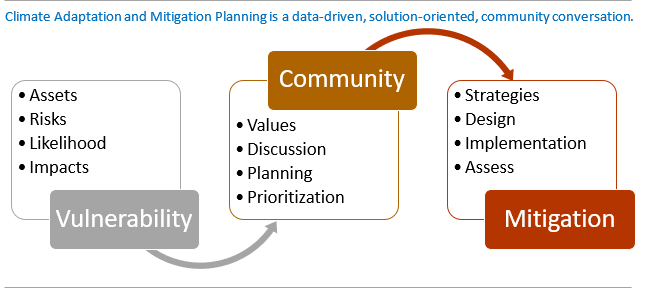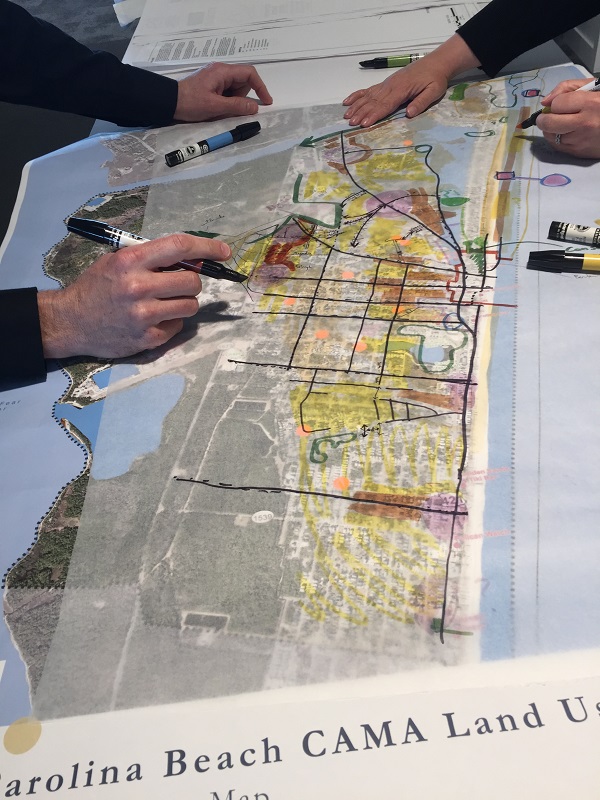
Planning to Rise Above an Uncertain Climate Future for Coastal Carolinas Region
Communities across the Carolinas are beginning to recognize that the future we face will be very different from the past. The climate is changing and predictions are that weather conditions will be more variable and more intense. North Carolina’s own climate risk assessment report acknowledges that future conditions will have more intense storms and associated flooding, more heat and drought, and that the seas will continue to rise.
All of this will put an enormous strain on our cities’ infrastructure – e.g. roads, stormwater, water and sewer pipes, septic systems, electrical transmission, and more. All of these systems were designed to accommodate the milder environmental stresses of the past. In addition to FEMA’s pending Risk Rating 2.0 reassessment of flood risk, credit rating agency Moody’s recent acquisition of a climate risk analysis firm signals a likely adjustment of city bond ratings based on exposure to increased climate-associated risks (including rising seas and saltwater intrusion, heat stress, stronger storms, greater flooding, etc.) and any actions planned by the jurisdiction to mitigate those risks.
PLAN FOR CHANGE
Communities across the nation are beginning to realize that if they use the best available science now and plan for change, they can mitigate the worst impacts and position themselves for a better tomorrow. The NC Office of Recovery and Resiliency recently released some quick start guidance on this issue.
The Georgetown Climate Center is tracking adaptation planning efforts across the nation. While the Carolinas currently have very few plans on the map, some communities are making incremental progress toward more climate resilient community design. Often this occurs in a piecemeal fashion, with mitigating actions or projects being inserted into plans as they are updated. Increasingly, communities are creating standalone Climate Adaptation and Mitigation Plans, which identify risks, vulnerability, mitigating actions, and then program resources to achieve those plans.
PROACTIVE PLANNING AVOIDS COSTS & LOSSES
Communities – especially coastal communities – that proactively plan for this new climate future will experience lower losses from disaster recovery, infrastructure maintenance, subsequent degradation in environmental quality, quality of life, property values, and financial solvency.
For example, coastal communities with rising seas may experience challenges associated with wastewater treatment during king tides and flooding events, such as sewer overflows or impaired septic drain field treatment. This results in increased pollution delivered to nearby waters, leading to negative environmental impacts such as nutrient pollution, algal blooms, fish kills and more. This decreased environmental quality can depress property values and reduce the attractiveness of the area. Studies of package treatment plants in the Bogue Banks by East Carolina University and of coastal wastewater collection systems by University of North Carolina Wilmington are revealing the hidden impacts that these communities are facing.
START NOW
With the complex and evolving nature of the science, infrastructure threats, and personal perspectives, Climate Adaptation and Mitigation Planning requires a measured and methodical multi-disciplinary approach to facilitating these complex discussions and decisions. The skills involved include a fundamental understanding of natural sciences, data analysis, policy and politics, urban design and landscape architecture, engineering, and finance.

The good news is that our communities did not pop out of thin air – they are the collective result of past decisions made under a certain set of conditions and with an understanding of the state of the world as it was. Many of these decisions have impacts that last for decades or longer. As we understand more about the changing nature of our climate future, we can respond to these new challenges by assessing our options and making new decisions.
The first step is having a community conversation about what we are facing, how likely and how costly these impacts might be, and what options we have to mitigate those impacts to ensure a prosperous future for our community. Engaging in Climate Adaptation and Mitigation Planning is how we will protect the places and people we love by proactively preparing for the future.

About the Author – Jay McLeod, MA Urban and Regional Planning, MS Biology, AICP, is Planning Manager with Stewart, a design, engineering and planning firm with offices in Raleigh, Durham, Charlotte and Wilmington in North Carolina, and Columbia, South Carolina.
McLeod has been professionally engaged for over a decade in varied public and private sector roles related to long-range planning, current/local planning, and state and regional planning. Having worked in many different settings, including municipal government, he focuses on outcomes that are both aspirational and achievable and that result in a better quality of life for stakeholders. His educational background in both ecology and urban planning also allows an additional focus on coastal CAMA land use planning and climate resiliency/adaptation planning.
Read related article published by GroundBreak Carolinas on November 12, 2019 https://groundbreakcarolinas.com/stewarts-data-driven-designs-help-strengthen-resilience-of-coastal-communities/







